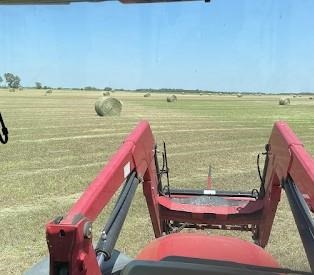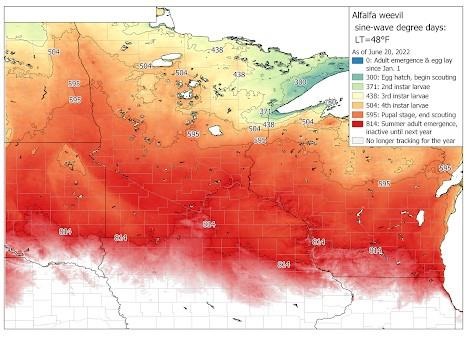By Anthony Hanson
Especially in central Minnesota, multiple calls have been coming in about what to do about alfalfa weevil in mid-June. After first cutting and seeing visible feeding damage in the regrowth, it may be tempting to immediately consider an insecticide, but threshold and mowing recommendations should still be followed this late in the season. That is because multiple factors, such as the weevil’s life cycle, mowing schedules, and hot temperatures can work in our favor and could make a return on investment on insecticide unlikely in multiple situations at this time. A May MN Crop News article went into detail on alfalfa weevil scouting and thresholds. This follow-up will address three main questions you should ask yourself towards the end of alfalfa weevil season:
- Do current mowing plans alter treatment decisions?
- Will the damaging stage (larvae) be present in the near-future?
- Are you in a window where insecticide applications are realistic or providing an actual benefit?
Depending on a grower’s operation, they may be close to their second alfalfa cutting for dairy, or may have recently finished their first crop for beef cattle. In a field that is fairly quickly mowed and baled, there is not much refuge or regrowth for weevils that managed to survive to feed on. The dry sunny days we’ve had near 100 degrees in the middle of June can be a significant stress for remaining larvae in an open field (Fig. 1). In fields like this, it is best to watch the regrowth and let the weather work for you. For fields that have significant cover and plant height, heat may not be a significant stress for the larvae, but there are still multiple factors to consider before any making a treatment decision.

Figure 1. Alfalfa field on June 20, 2022 shortly after baling. The field had reached threshold shortly before mowing with few larvae found in remaining stubble. High temperatures and no cover make this a challenging environment for larvae, and insecticide treatment is not being considered at this time for these reasons.
In Minnesota, especially with our cold winters, we only have one generation of alfalfa weevil per year: overwintering adults lay eggs in the spring, larvae develop through May and June, and feeding is done once larvae pupate and enter a dormant period as adults. It is possible for larvae or pupae to survive during warmer winters in more southern states (subsequent adults will lay eggs later than a typical overwintering generation), though it is not documented how much this may occur in Minnesota. Adults do not cause economic damage, so scouting occurs only for larvae. Mid to late June is when larvae are finished developing at the 4th instar stage (about 5/16th inches long) and will not be feeding once they turn into pupae or enter adult summer dormancy. The end of larval development means there isn’t going to be additional yield loss to protect against with insecticides, and this can be predicted with degree-days (https://vegedge.umn.edu/alfalfa-weevil). As of June 20, the average larva should at least be entering the pupal stage in the southern two-thirds of the state (Fig. 2).

Figure 2. Accumulated degree-days for alfalfa weevil in 2022. Daily weather data from US National Phenology Network.
However, some growers may still be finding larvae in their fields, though most of these should be mature larvae ready to stop feeding and pupate soon. This can be due to variation with more localized weather or even the degree-day model itself in addition to other environmental factors that may prolong development. Even if damage was seen in early regrowth, continue scouting to see if larvae are actually present in sufficient numbers now.
If thresholds are met, there are still decisions to make before settling on an insecticide application. If the field is going to be mowed within a week, especially since many insecticides labeled for alfalfa weevil have a pre-harvest interval around 7 days, consider mowing slightly earlier than planned.
With pre-harvest intervals, the weevil lifecycle, and potential mowing schedules, there is a relatively narrowed window right now where insecticides could be feasible depending on the specific field. If a field falls within this window and has reached threshold, then it is time to determine if you want to continue monitoring for natural population decrease or apply an insecticide.
Especially with chlorpyrifos' registration revoked, there have been calls from growers asking about what appears to be issues with lambda-cyhalothrin applications and what remains for options. This could be due to spray timing related efficacy issues or possible pyrethroid resistance, which has not yet been officially confirmed in MN quite yet. Some pyrethroids, such as bifenthrin, are only labeled for alfalfa seed production and not for forage use. If a pyrethroid was already used on the field this year, the remaining options are to alternate to a non-chlorpyrifos organophosphate (e.g., dimethoate only has a suppressive effect) or indoxacarb (e.g., Steward), which has been difficult to obtain this year.
The narrow list of insecticides hopefully illustrates why alfalfa insecticide applications should be minimized to when they are truly needed in order to preserve the few insecticides we have available. This is also a great example of how insecticides are the last step in a list of considerations in an effective IPM program because the best return on investment for management tactics depends on weighing the pest biology and crop status before making a treatment decision.
Alfalfa weevil is one pest that should be regularly scouted for in early-season alfalfa for possible treatment, but finding larvae now is not a guarantee you'll have issues a week later. In that case, keep scouting and following treatment thresholds while keeping in mind both when the next cutting will be and that larval populations will drop for the year as they develop into pupae. There could be fields worth treating right now, but remember that an unneeded application now could also complicate your remaining options for late-season alfalfa insects like potato leafhopper.
Source : umn.edu